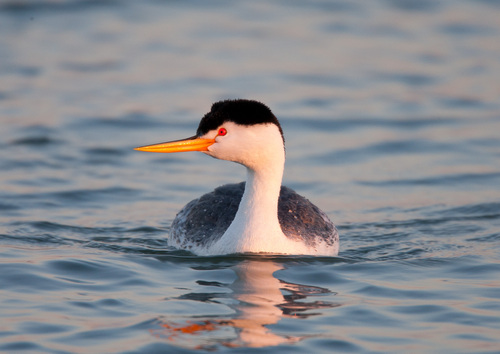
Clark's Grebe
Clark's Grebe (*Aechmophorus clarkii*) is a striking waterbird known for its elegant courtship displays and close resemblance to the Western Grebe. Once considered a color morph of the Western Grebe, Clark's Grebe was recognized as a distinct species in 1985. It plays a vital role in freshwater ecosystems, primarily as a fish predator. This species holds cultural significance in some Native American traditions, often associated with water and transformation.
56-74 cm
Length
79-102 cm
Wingspan
Least Concern
Conservation Status
Distribution
Breeds primarily in western North America, from southern Canada to Mexico. Winters along the Pacific coast from southern Alaska to Mexico, and inland in parts of the southwestern United States and Mexico. Rarely found east of the Rocky Mountains.
Lifespan
Up to 15 years in the wild, though average lifespan is likely shorter. Captivity data is limited.
Clark's Grebe's Habitat
Habitat Types
Freshwater lakes, Marshes, Reservoirs, Coastal estuaries (during winter)
Climate Zones
Temperate, Subtropical
Adaptations
Lobed toes provide excellent propulsion underwater. Dense, waterproof plumage protects against cold water. Legs are positioned far back on the body, aiding in diving but making movement on land awkward.
Variations
No recognized subspecies, but some regional variation in size and bill color intensity has been noted.
Appearance
Breeding Plumage
Breeding plumage is more vibrant, with a sharply contrasting black and white pattern. Non-breeding plumage is duller, with more gray.
Seasonal Feather Changes
Transition to breeding plumage occurs in late winter/early spring. Molting into non-breeding plumage occurs after the breeding season.
Sex Based Plumage Differences
Minimal, primarily in bill color intensity. Males generally have brighter yellow bills.
Notable Features
Bright yellow or orange-yellow bill (distinguishing it from Western Grebe), White flanks and underparts, Black cap that does *not* extend below the eye (unlike Western Grebe), Red eyes
Diet and Feeding
Primary Foods
Small fish, Crustaceans, Aquatic insects, Polychaete worms
Foraging Behavior
Dives underwater to pursue prey, using its feet for propulsion. May also glean insects from the water surface. Often forages in flocks, sometimes coordinating dives.
Specializations
Serrated bill edges help grip slippery fish. Stomach lining can form a pellet of indigestible fish bones and feathers, which is regurgitated.
Seasonal Diet Variations
Diet may shift slightly depending on prey availability, with more crustaceans consumed when fish are less abundant.
Behavior
Social Structure
Forms large breeding colonies, often mixed with Western Grebes. More solitary or in small groups during the non-breeding season.
Communication
Vocalizations include a variety of calls, including advertising calls, contact calls, and alarm calls., Visual displays, such as the rushing and weed ceremonies, are crucial for pair formation and maintenance.
Migration
Migratory, moving from inland breeding areas to coastal wintering grounds. Migration occurs primarily at night.
Territorial or Group Behaviors
Territorial during the breeding season, defending nesting sites. Forms large, coordinated foraging flocks at other times.
Conservation
Threats
Habitat loss and degradation (wetland drainage, water pollution), Oil spills, Entanglement in fishing gear, Disturbance from human activities (boating, recreation)
Protection Programs
Migratory Bird Treaty Act protection, Conservation of wetlands and other important habitats, Monitoring of populations and breeding success
Local National Laws
Protected under the Migratory Bird Treaty Act in the United States, Canada, and Mexico.
Population Trend
Stable
Population Estimates
Global population estimated at 140,000 individuals.
Interesting Facts
They are known for "dancing" on water.
The rushing ceremony is a spectacular display of synchronized running across the water surface.
Chicks ride on their parents' backs.
This behavior provides protection from predators and helps regulate the chicks' temperature.
They eat their own feathers.
Ingested feathers help protect the digestive tract from sharp fish bones and form pellets for regurgitation of indigestible material.
Faqs about Clark's Grebe
How can I tell a Clark's Grebe from a Western Grebe?
Look at the bill color (Clark's is bright yellow, Western's is greenish-yellow) and the extent of the black cap (Clark's does not extend below the eye, Western's does).
Where can I see Clark's Grebes?
Look for them on freshwater lakes and marshes in western North America during the breeding season, and along the Pacific coast during winter.
Are Clark's Grebes endangered?
No, they are currently listed as Least Concern by the IUCN, but they still face threats from habitat loss and pollution.
Copyright @ Nature Style Limited. All Rights Reserved.
 English
English